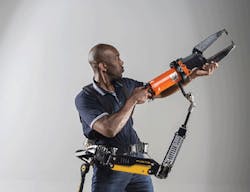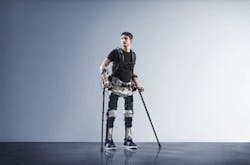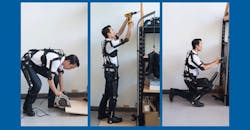When Homayoon Kazerooni arrived from Iran to America in the late 1970s, he had just a few hundred bucks in his pocket. He also had big dreams.
They weren’t the usual American dreams of being rich and famous. He dreamed of becoming a scientist or an engineer, like the people he read about in outdated Time magazines back home who helped Neil Armstrong take his first small steps in the Sea of Tranquility.
Four decades later, those dreams would be fulfilled. An invention he helped build allowed someone else to take steps just as groundbreaking as Armstrong’s – and ended up in the pages of Time as one of the publication’s 50 Best Inventions of 2010.
Called the eLEGS, the device was a medical exoskeleton that restores the ability of paraplegics, MS patients and stroke victims to walk.
For those people, an exoskeleton that offers untethered bipedal locomotion really is as amazing as the Moon landing, probably even more so. Honestly, the Moon is pretty boring in comparison.
Bionics that pull off some Biblical-style miracles? That’s what science is all about, and it’s the realization of Kazerooni’s personal American fairy tale. It’s about a boy orphaned at a young age who heard tales of wonderful machines and super heroic scientists in a strange, foreign land; tales that would lead him to come to America to see it for himself just months before a revolution would upend his homeland.
Eventually, he would transform the equivalent of $1,100 into a doctorate at MIT and a 27-year-tenure at Berkeley in the mechanical engineering department. Finally, he would use his skills and drive to bring forth the age of exoskeletons, a technology that will soon wrap itself around every aspect of our lives.
Well, that’s the story if you’re one for hyperbole. If you’re Kaz, as his friends and students know him, you’re just doing your job.
“I’m an engineer,” he says. “My job is creating technology to make life easier and to create a better quality of life.”
Mass Exo-dus
Kaz’s exoskeletons certainly fit his utopian description of tech that creates a better life. But Neil Armstrong’s few Moon steps evolved into a round of golf and we’re still looking for the next giant leap – to Mars.
With exoskeletons, you don’t need them to jump to be considered a miracle. They just need to be functional, durable, affordable, comfortable and flexible.
The quest for that has launched a new engineering race to see who will deliver the first mainstream exoskeleton.
If a major conglomerate does it, that particular robotic wearable could go into mass production earlier and probably reach more people faster. Lockheed Martin and Parker Hannifin have products for industrial and healthcare use – the FORTIS and the Indego, respectively.
The FORTIS, the first exoskeleton for industrial use, was developed for heavy tool-holding at Naval shipyards and other industrial applications. It reduces muscle fatigue by two-thirds and costs around $23,000. The Tool Arm alone sells for $7,149, with the customized gimbals sold separately.
Parker’s 26-pounds Indego offers people with spinal injuries upward mobility. The battery lasts four hours and settings can be changed via smartphone. The sleek FDA-approved machine is cleared for clinical and personal use and costs $80,000.
If it’s a startup, manufacturing the definitive exoskeleton could make it the next big Fortune 500 company. For Kazerooni, it’s a race against himself.
The eLEGS, now called the Ekso, were created at the Berkeley Robotics & Human Engineering Laboratory, which he directs, and Berkeley Bionics, which he co-founded. They also rebranded as Ekso Bionics. Prior to the name change, Kazerooni left the business for more autonomy and freedom to express his singular vision.
“Engineering is like artwork,” explains Kaz, a painter on the side. “When you go through art school, they teach perspective, color and light. But you can’t become a Michelangelo unless you do it yourself.”
So, he went back to Berkeley from Richmond, Calif., where Ekso is based. No longer a leader of an up-and-coming company with a licensing agreement with Lockheed, Kaz went back to teach. And to develop a new, better exoskeleton that wouldn’t infringe on patents he already made.
He would have to start over.
A New Bionic Better than the Old Bionic
Starting over has never been a problem for Kaz. He did it in Madison, at the University of Wisconsin, and then a year later at MIT, and again on the West Coast.
It’s especially easy when you have a university lab unofficially named after you, the Kaz Lab. In college, he had to clean the lab for extra money. Now he has fresh batches of grad students delivered to him annually, all of them intent on changing the world.
“I want to teach and give them something so they can be better for all of us,” the professor says.
He also wanted this new bionic to be even better than the last one he helped create, and that one is very, very good. But it comes with a price that makes it unfeasible for most.
This next model would be stripped down, economical in every way and won’t sacrifice performance. This isn’t some luxury item, it’s for people who really have to think about everywhere they go, if it’s accessible, how long could they manage and so on.
“We have to take care of those around us, weaker than us,” Kaz says.
And he stands up for them by helping them stand themselves. It’s because of his inventions they now can hope for a better life.
“Hope is a huge power in all of us, and you can’t feel it unless you lose it,” he says. “Every person has experienced a moment in their life where they have had no hope. I had been in that position where I wanted to stay in bed. When you have no hope, you can’t function.”
So that’s the mission: Restoring hope in as many people as possible in a world that gets more cynical every day.
Kazerooni is happy to be just one of the many minds involved in this project, because it’s the science that matters. Who cares about making a name for yourself when people’s lives and livelihoods are at stake?
What introspection he does afford himself gives him an unassailable fatherly quality: “I came here with very little, and I got opportunities. With opportunity comes responsibility,” he says.
Austin Whitney
“Today we have just seen a wondrous example of Berkeley at its finest,” Chancellor Robert Birgeneau told the crowd in May 2011.
A man named Austin Whitney had just done something he thought he’d never do: walk across the Berkeley campus stage to receive his diploma. He was paralyzed in a car crash in 2007. Then he met Kazerooni.
Four years later, Whitney rose from his wheelchair and accepted his degree and a hearty hug from the chancellor. He still needed the support of a walker connected to a newly designed set of exo-legs made from mostly off-the-shelf parts.
Truly, this was a miracle, and Kaz was happy so many bore witness.
“The most important thing is when I saw the other students who were able to see the results of our work,” he says. “I was able to educate a whole group of people.”
As impactful as inspiring a whole generation is, Kaz recalls how excited Austin was for a different accomplishment prior to the ceremony: standing up to pee – an able-bodied luxury he had been denied for at least four years.
Austin was so excited “he went in there and was screaming,” Kazerooni recalls.
The Austin prototype became the Phoenix, the robotic avatar designed to help its users rise from the ashes.
Steve Sanchez
One of those users was Steve Sanchez.
Sanchez was paralyzed in a BMX accident near San Jose in 2004. He bailed mid-jump and fell wrong. That one miscalculation led to an irreparably damaged spinal cord and what he thought would be a lifetime in a wheelchair. For an adventurous 17-year-old, the hope he clung to was finding a cure.
He traveled to China for stem cell therapy and eventually resorted to painful leg braces.
“I trained to kill the nerves in my hands so I could stand up longer,” Sanchez says laughing. “I was destroying my hands, the things I had left, for the ability to walk maybe 10, maybe 20 feet before I was so exhausted I couldn’t move again.”
Sanchez says it took “150 percent effort“ to take a few steps.
His roommate had worked with Kazerooni testing the eLEGS and was invited to test Kaz’s new medical exoskeleton developed by the newly formed suitX prototype in the summer of 2012. The roommate wasn’t all that interested, but Sanchez saw this as his opportunity.
A week later, Sanchez was wearing the new prototype and walking down the hallway to his parents. That moment was caught by a BBC documentary filmmaker, and is NSFW if you have a tough guy image to protect.
He’s now the product’s chief test pilot, and because of his background as a CNC programmer and inspector, checks all suitX products prior to assembly.
The guy who is uniquely suited to use the suit also is responsible for quality for the whole company.
“It gives a more natural motion, it feels more like I’m walking,” Sanchez says. “I’m at about 10-15 percent effort.”
He tried on both the Ekso and the ReWalk Robotics exoskeleton, both of which can cost more than $80,000. They both have powered knees, a good feature for climbing, but feel akin to a roller coaster while the Phoenix is a bicycle, he says.
Recently, Sanchez, a wine enthusiast, ventured out to Napa Valley with the suit, wearing it out in public for the first time while not on company time. Instead of sitting near the lower tables, Sanchez popped up and stood at the bar, with people now filled more with curiosity than pity.
“They see the wheelchair moving, they don’t see the person,” he says. “Being able to stand there, eye-to-eye with everybody, really hit me to a point where I really felt alive again.”
The Phoenix currently is awaiting FDA approval, which could come by early 2018. Kaz expects it to retail for $30,000. That’s the price of a Camry, not a Corvette, and well within someone’s means.
“In 10 years, it could cost $10,000,” Sanchez says, and that’s a number Kaz finds within the realm of possibilities.
There’s another impending robotic development, though, that is on a collision course with society: Robots in the workforce.
eXo-Manual Labor
Robots are taking over the industrial work place; it’s inevitable. Take your pick of studies or just look on the plant floor. They grow every year in number, increase in applications and drop in cost.
Most imagine the science fiction version of exoskeletons, such as the industrial CAT Power Loader in Aliens to the military power suits in Edge of Tomorrow, but really, they’re just robotic tools.
“As presented by sci-fi in the last 15 years, exoskeletons are about a man going inside a machine, running and punching people – Iron Man-type things,” Kazerooni says. “It’s augmenting them to fight.”
It’s a premise first explored in Robert Heinlein’s Starship Troopers, and in 2000, DARPA gave funding to the Berkeley lab to flesh out its Berkeley Lower Extremity Exoskeleton (BLEEX), consisting of motorized legs, sensors and actuators; a battery; and back pack frame, diverting the weight of a 75-pound load out to the robot, not the grunt.
“You put $100,000 into training one soldier, and then they get a back injury from carrying a load,” explains Kazerooni. “My very early proposal had nothing in there to make soldiers stronger. We always talked about ankle injuries, back injuries.”
The team worked on a more combat-ready version of BLEEX: the hydraulically-powered HULC, or Human Universal Load Carrier, which was announced in 2009 and seemed to go more the teenage-boy version of an exosuit route. The 53-pound HULC allows the user to carry up to 200 pounds and run 10 mph. Lockheed Martin licensed the rights, and it seemed to be the start of the military trying to go full Iron Man.
For more mechanical miracles, check out our photo gallery here.
Kazerooni also had been working with the Department of Labor, trying to identify how to prevent worker injuries through the robotics tech he specializes in.
The BLS says that 25,000 total warehouse workers, or 5 percent, suffered work-related injuries in 2015. Overextertion injuries overall cost $15 billion a year, and $68 billion when you factor in lost productivity, training new workers, higher insurance costs and more.
One solution has been to automate more and add more robots everywhere.
While Kazerooni concedes robots simply work better and more safely in fixed repetitive tasks, like spot welding in an auto factory, he adds that even smart robots have trouble handling different shaped objects. None has the mobility and intelligence of a primate honed through millions of years for problem-solving, so his latest exoskeleton combines the best of both worlds.
“Why not combine human intelligence with robotic strength?” Kazerooni asks. “That’s the thesis of my work.”
A Winning Combo
Kaz’s latest exoskeleton is called the MAX, short for Modular Agile eXoskeleton, and its Kaz’s simplest, cheapest and most far-reaching invention yet.
That experience with the Department of Labor helped him identify the three problem areas for a worker: the back, knees and shoulders. So, the MAX uses compressed springs to mechanically resist forces, such as a cement block you picked up. If you’re wearing the whole shebang, when you bend over the legX piece kicks in to relieve strain at the knees and the backX diverts the weight of your torso and the object through the steel and aluminum frame down to the ground, not your spine. Then, if you have to hold that block above your head to hand it to someone on another level, the shoulderX takes the weight.
There are no batteries and you can put it on in less time than it takes to put on a three-piece suit. The whole device costs $11,000 but is available as separate units: $3,000 for the backX and shoulder, and $5,000 for the legX.
“Based on experiments done in the lab, we are dropping stresses by about 50 percent for payloads of 30 or 40 pounds,” Kazerooni explains. “As the payloads go up to 100 pounds, they reduce about 40 percent. If you’re picking up 50 pounds, it makes it feel like 20 to 25 pounds.”
Let’s say you bend over to pick up 20-pound boxes eight times a minute, for 8 hours a day. That’s 19,200 bends a week. If you had to do this for 50 weeks a year, and wore the backX for three years, you are paying about a dime extra a lift and likely preventing an injury that could cost a ton more and haunt you with nagging back aches the rest of your life.
“The way I see it, we’re just making it so a FedEx worker doesn’t get injured,” Kazerooni offers.
As previously mentioned, the MAX can reduce the relative weight of an object by 50 percent. A UC Berkeley study on the backX found that it averages a 60 percent reduction in EMG muscle activities at four of the most injury-prone lower back muscle groups.
That’s the big thing with this exosuit. It’s real, for real people and it works. It looks about as cool and sexy as a safety harness.
One thing Hollywood doesn’t show you is that when the camera isn’t rolling, their exosuits are glorified props, needing to be moved with chains, the actors having to be lowered into them. You can drive a car or do yoga in the MAX, and it takes under a minute to put any piece on.
When you’re at war with real robots, not CGI aliens, that’s gotta’ count for something.
Engineering the Future
Will this be the exoskeleton that takes off? At this point, it’s hard to say.
Kaz’s former company has its own industrial exoskeleton, the $5,000 EksoWorks Vest, which supports tool holding at waist level. BMW is expected to have 68 in service at the Spartanburg, South Carolina plant.
The Noonee Chairless Chair, which works a bit like the legX, also is being tried out there to help people take a load off.
And another professor, Tom Sugar at Arizona State, has developed a hip exoskeleton as part of the DARPA Warrior Web Program. Sugar says that applying an assistive force 5 to 15 Newton meters of torque, a person’s stride is increased and pushes them to walk faster. Figuring that some manufacturing workers walk 10 to 15 miles a day in the plant, this would give them a 10-15 percent speed boost.
SuitX has one thing going for it the others don’t, and that, of course, is Kazerooni. He has become the de facto Father of Exoskeletons, and for good reason.
Working his way up from nothing, he feels the plight of the common worker, and he has a sense of justice that the underdog must not only be protected, but lifted up so that one day no one feels the depths of despair due to a disability.
Kazerooni stays in his basement lab at Etcheverry Hall and gets to work on his next miracle: inspiring his students to become the next Kaz... or least to work as hard as they can to get the most out of their abilities.
“I don’t take this lightly,” he says. “I have to make them good engineers. That’s the way we make the future.”
About the author: John Hitch, a staff writer at New Equipment Digest, is from Cleveland, Ohio, where he writes about manufacturing technology and trends.



